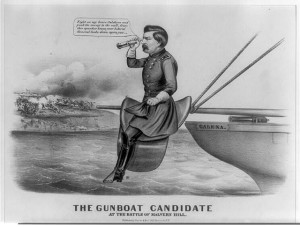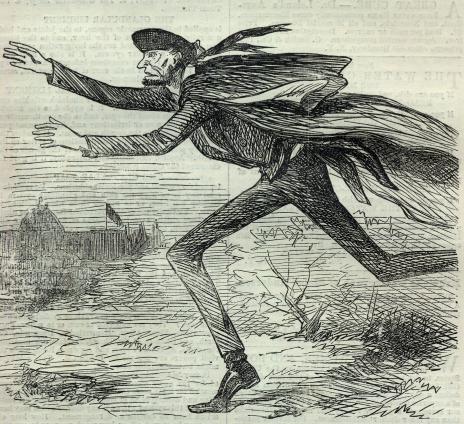The following Democrat article ignores the fact that President Lincoln exposed himself to rebel fire at Fort Stevens – probably imprudent, but not exactly cowardly.
From a Seneca County, New York newspaper in October 1864:
Who is in the Gunboat Now?
The Evening Journal and a host of papers of the baser sort, are filled with falsehoods about McClellan taking refuge on the gunboat Galena, in the James river. – We have shown the falsity of the imputation; and the story has been put to the winds a score of times. But unfortunately for Lincoln it revives a story as to him which is too true. The Philadelphia Age gives it:
Unfortunately for Mr. Lincoln, there are two sides to this gunboat story! It is now pretty well settled that A.L. has had some gunboat experience, not at all calculated to increase his reputation for valor. During the recent rebel invasion of Maryland, when their forces attacked the fortifications in front of Washington, the President of the United States took up his quarters on board of a gunboat lying in the Potomac, with steam up, ready to start at a moments’ warning, and remained there for the greater part of two days. The failure of the rebels to accomplish anything at Fort Stevens, and their withdrawal from Maryland, reassured the valiant Lincoln, who, after trembling for nearly forty-eight hours on board the gunboat aforesaid, again took up his quarters in the Presidential mansion, and at once recommenced his philanthropic labor in behalf of negro equality.
This was not the first time that Lincoln laced his trust in gunboats! He had one in the Potomac in 1862, during the terrible panic, which was kept with steam up for several days. A special locomotive train was engaged at the same time, and the locomotive was kept under a full head of steam day and night for a week. Whether the military cloak and Scotch cap, in the disguise of which Lincoln entered Washington, were on hand, is not known; but he was ready again and again for an unheroic flight. – Argus.


![Abraham's dream!--"Coming events cast their shadows before" (by Louis Maurer, [New York] : Published by Currier & Ives, 152 Nassau St. N.Y., c1864; LOC: LC-DIG-ppmsca-19400)](https://www.bluegrayreview.com/wp-content/uploads/2014/10/19400r-300x234.jpg)
